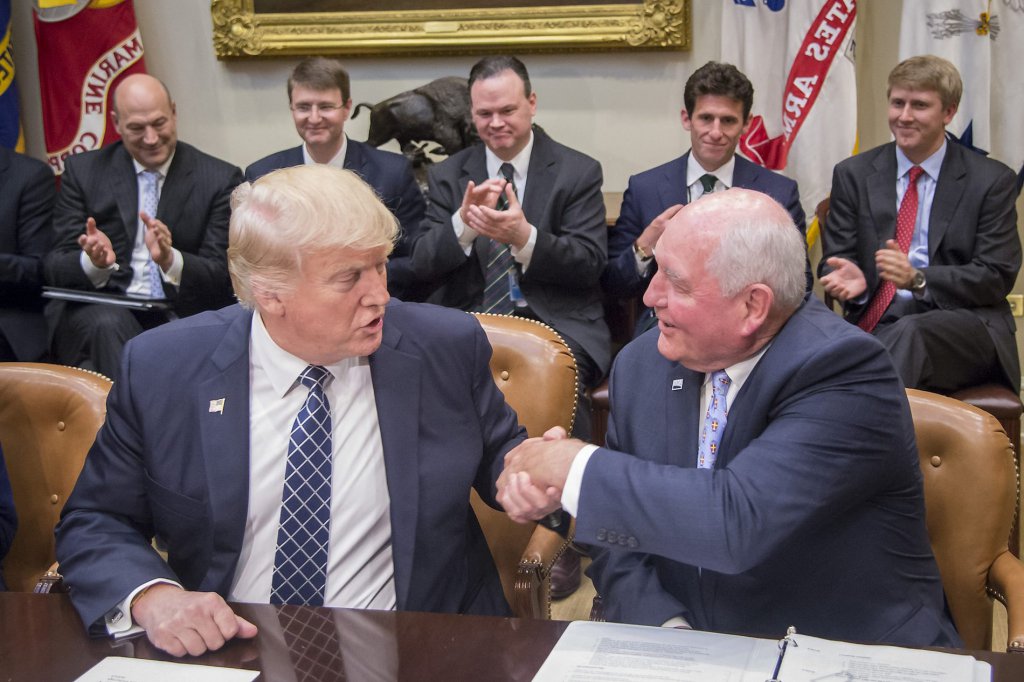
USDA
On his first day on the job as the long-awaited new Secretary of the United States Department of Agriculture (USDA), Sonny Perdue, a former two-term governor of Georgia, addressed two very different audiences. First, in his formal introduction to USDA staff, Perdue laid out his general vision for the department’s next four years.
“The only legacy I seek is the one that any grandparent seeks — that is to hand off our nation … our fields and our farms to the next generation in better shape than we found it,” Perdue said.
His second engagement was a meeting with President Trump and 15 agricultural producers from around the country. The roundtable featured mostly large-scale meat, dairy, grain, and specialty crop producers, as well as the current North Carolina Commissioner of Agriculture, Iowa Secretary of Agriculture, and former California Secretary of Food and Agriculture.
Immediately following the meeting, the President signed an executive order establishing an inter-agency Task Force on Promoting Agriculture and Rural Prosperity in America. The Task Force, which Secretary Perdue will lead, is charged with studying the struggles of rural Americans and identifying “legislative, regulatory, and policy changes to promote in rural America agriculture, economic development, job growth, infrastructure improvements, technological innovation, energy security, and quality of life.”
In Perdue’s first two major outings we can already see signs of the push-pull that will no doubt influence this administration’s work on agriculture. On the one hand, the Secretary has pledged to support the diversity of American agriculture, including small, mid-sized, and organic family farms, as well as young and beginning farmers and the growing local/regional food industry. He has also repeatedly made statements indicating that land stewardship and natural resource conservation would be cornerstones of his tenure.
On the other hand, the President and Secretary have surrounded themselves almost exclusively with large-scale, industrial commodity farm and business owners. They have yet to offer substantive details about how they will address the growing economic crisis in agriculture. At they same time, they’ve proposed huge budget cuts to programs that assist farmers and rural businesses and communities.
If Secretary Perdue truly wishes to be a champion for the entire American agricultural community in all its breadth and diversity, there are ten things that he should take leadership on right away.
 USDA
USDA 1. Finalize the Farmer Fair Practices Rules and issue a plan for enforcement
 USDA
USDA 2. Protect family farmers by rejecting the President’s proposed cuts to USDA, including the proposed elimination of the Rural Business Cooperative Service
Among the programs currently on the chopping block are rural water and wastewater management, cooperative, and business programs – programs with a proven track record of success both in terms of business survivability rates and job creation. To call such vital programs ‘underperforming,’ as the skinny budget does, reflects a lack of understanding of their function and impact.
 USDA
USDA 3. Protect working lands conservation programs and conservation technical assistance
 USDA
USDA 4. Create opportunities for the next generation of farmers and ranchers
 USDA
USDA 5. Create jobs and spur industry growth by expanding local and regional food infrastructure
 USDA
USDA 6. Strengthen our food security and climate resilience by scaling up and strengthening agricultural research programs
 USDA
USDA 7. Get USDA’s house in order by issuing overdue Requests for Applications immediately
- Value Added Producer Grant program (VAPG): Provides competitive grants to producers for working capital, feasibility studies, business plans, and marketing efforts to establish viable value-added businesses.
- Outreach and Assistance for Socially Disadvantaged Farmers and Ranchers Program (aka “Section 2501”): Provides grants to colleges and universities and community based organizations to provide outreach and assistance to socially disadvantaged and veteran farmers and ranchers to overcome the unique challenges they face in agriculture.
 USDA
USDA 8. Focus on substantive improvements to programs and policies, not on reshuffling USDA to make room for a new Under Secretary
Given the complexity and importance of resolving this issue, Secretary Perdue should move forward expeditiously with the development of a comprehensive, department-wide strategy.
 USDA
USDA 10. Ensure that Food Safety Modernization Act (FSMA) regulations are helping, not hurting, small and mid-sized family farm operations
- Prioritize Food Safety Outreach Program (FSOP) applications from organizations that represent or work directly with farmers to ensure appropriately tailored and accessible outreach, training, and technical assistance.
- Create a department-wide initiative that highlights USDA services and programs that support farmers in complying with FSMA requirements











